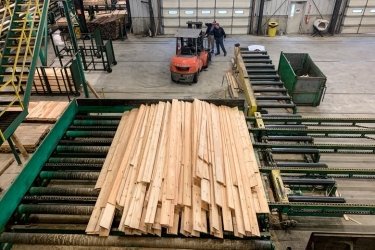Henry Grabar addresses a question currently puzzling Americans.
On the demand side, the lumber issue is relatively straightforward: Americans are flush. Interest rates are low. Wealthier households are buying pandemic-proof second homes or diving into long-awaited renovations. Younger families are trying to buy starter homes and settle down. Many multifamily builders have turned to timber as well, which is now commonly used to frame five- or six-story buildings. All that has created enormous demand for wood.
But the case of lumber supply is a little more perplexing. True, shipments from Canadian forests, which contribute about one-third of U.S. lumber consumption, have been constrained by tariffs, beetle infestations, and wildfires. But there is plenty of wood on both sides of the border, and fast-growing pine in the U.S. South is actually cheaper than it’s been in two decades. …
Instead, the culprit is the decade of instability and low prices that followed the Great Recession, when America stopped building homes, leaving the lumber trade out to dry. The stunted recovery stripped the industry’s crucial middlemen—the mills themselves—to the bone. Building a new deck is expensive now because mills can’t ramp up to meet the demand surge—or won’t, nervous they’ll get caught with millions in underused machinery when prices crash back to earth.
HT: Karen L. Myers.






Lee Also
Something no one seems interested in: When the Mead Family got out of Mead WestVaco, they took with them the land that Mead WestVaco owned. And they have been busy selling it off for lots of money. I live in South Carolina where GINORMOUS subdivisions are going in what lumber stands once stood.
How much have the Meads sold off, that is going out of lumber production? One third of ALL the lumber stands in South Carolina and Georgia. Once the lumber from them is harvested, it will not be replanted. And that’s ALL — not one third of the land owned by the Meads. ALL e sources of commercial southern yellow pine in Georgia and South Carolina.
That’s going to negatively impact lumber costs in the Southeast. If it had not already.
FWIW, idiots ran the local formerly Mead WestVaco, formerly Kapstone, formerly WestRock lumber mill… Well, since Interfor bought it, they’ve been firing some of the idiots, so who knows if the collective IQ has gone up.
Anyhow, they are only one, I know. But under Kapstone, they did invest in machinery in the past ten years: grade scanner, some comprised trimming device, other high tech stuff, plus stuff I don’t know about in the dry kiln. A fair amount of high, high tech computerized equipment. They have it — but don’t know how to use it. And there has been a general attitude of “We did it this way for years…”
So while the above may be true for the North, I seriously doubt it’s true here in Southern Yellow Pine country. My money is on too stupid and too intransigent her in the sunny South to use the new equipment to keep up with demand.
Please Leave a Comment!